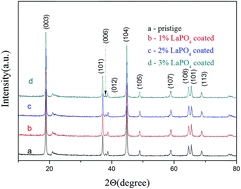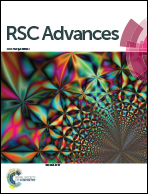LaPO4-coated Li1.2Mn0.56Ni0.16Co0.08O2 as a cathode material with enhanced coulombic efficiency and rate capability for lithium ion batteries†
Abstract
In this paper, pristine Li-rich layered oxide Li[Li0.2Mn0.56Ni0.16Co0.08]O2 porous microspheres have been successfully synthesized by a urea combustion method, and then coated with 1.0%, 2.0%, and 3.0 wt% LaPO4 via a facile chemical precipitation route. The structures and morphologies of both pristine and LaPO4 coated Li1.2Mn0.54Ni0.16Co0.08O2 were investigated by X-ray diffractometry (XRD), field-emission scanning electron microscopy (FESEM) and high resolution transmission electron microscopy (HR-TEM). XPS data and FESEM demonstrate that the LaPO4 was successfully coated on the surface of the Li[Li0.2Mn0.56Ni0.16Co0.08]O2 porous microspheres. Especially, the 2 wt% LaPO4 coated-Li[Li0.2Mn0.56Ni0.16Co0.08]O2 demonstrates the best electrochemical performance. As lithium ion battery cathodes, the 2 wt% LaPO4 coated sample, compared with the pristine one, has shown significantly improved electrochemical performances: the initial coulumbic efficiency improves from 78.81% to 84.76% at 0.1C and the rate compatibility increased from 70 mA h g−1 to a high capacity of 112.73 mA h g−1 at a current density of 5C. The analysis of dQ/dV plots and electrochemical impedance spectroscopy (EIS) demonstrate that the enhanced electrochemical performance is mainly attributed to the fact that the LaPO4 coating layer can not only stabilize the cathode structure by reducing the loss of oxygen, but also protect the Li-rich cathodes by decreasing the side reactions of Li[Li0.2Mn0.56Ni0.16Co0.08]O2 with the electrolyte and lower the charge transfer resistance of the sample.


 Please wait while we load your content...
Please wait while we load your content...